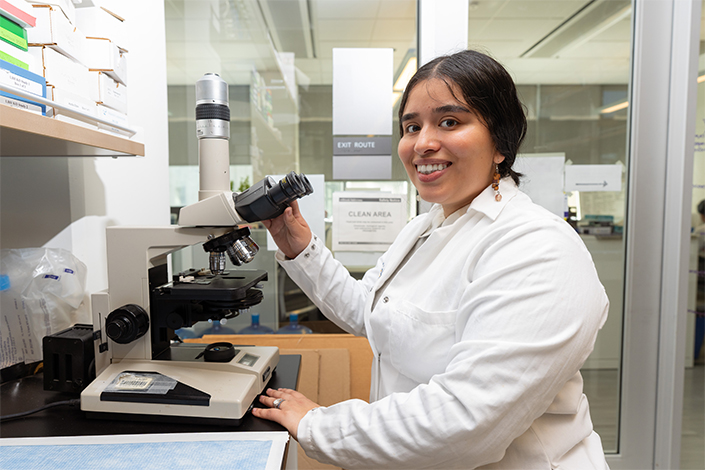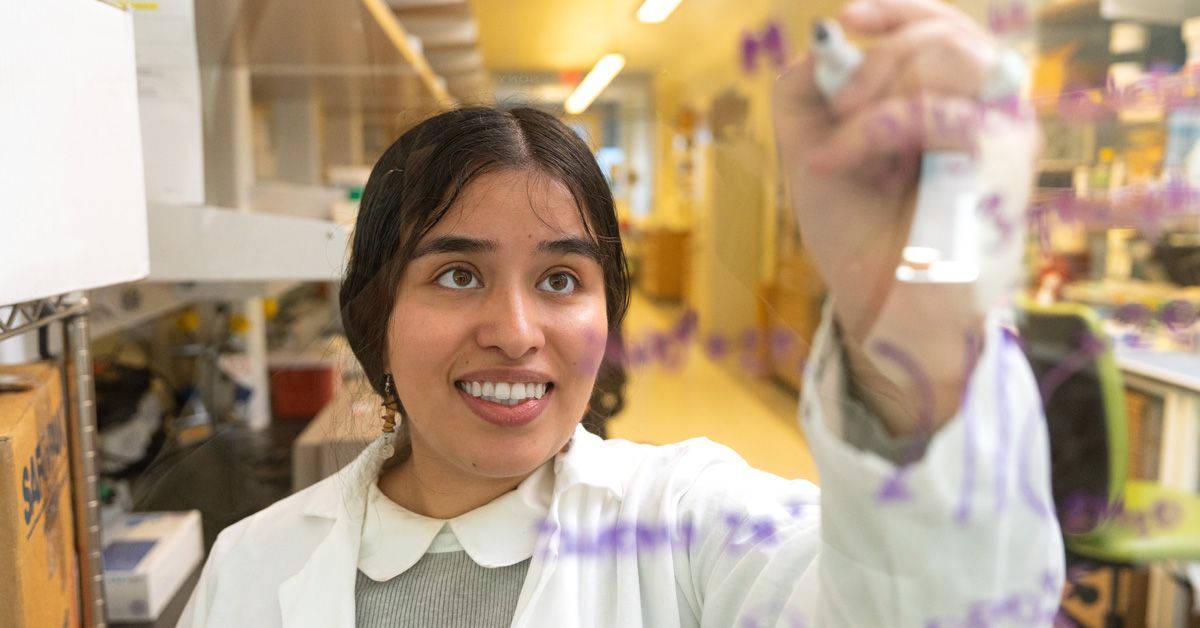The Language of Numbers - Luna Glenn Reyes
Story by:
Published Date
Story by:
Topics covered:
Share This:
Article Content
When Luna Glenn Reyes moved to the United States from Mexico at age 10, she didn’t speak any English. But she did speak the language of numbers.
“Math always came naturally to me — it was my safe space,” said Reyes, a first-generation college student. “I started doing math competitions in middle school. I couldn't speak English, but I was like, I know what's going on with the numbers.”
Eventually, Reyes considered pursuing a career in physics or economics to use her math skills, but she found herself drawn to making sense of the patterns of health disparities she had observed in her family and community — and improving the lives of others.
During the COVID-19 pandemic, while delivering groceries for Instacart, she paid attention to trends in the nutritional value of food people ordered.
“It got me interested in public health,” she said. “I realized I wanted to help people, I just didn't think I could help people using math, especially in relation to their health and the factors that affect it.”
When Reyes discovered biostatistics, a sub-discipline of public health, she realized she could test observed patterns scientifically to answer all kinds of health-related questions, rather than just making assumptions about what caused those patterns. And as for helping people, it checked all the boxes.
“Biostatistics is almost like a niche that's specifically for me,” Reyes said.
During her CADRE internship, Reyes worked with mentor Lindsay Burnett, M.D., Ph.D., an assistant professor in the Department of Obstetrics, Gynecology & Reproductive Sciences at UC San Diego School of Medicine, and her research team, investigating women’s pelvic floor disorders in the lab and the clinic.
“It's a chronic disease and it's not an infectious disease, so it's very much under the radar, but it definitely affects quality of life,” said Reyes.

Pelvic floor muscles can be damaged with aging and vaginal childbirth, predisposing women to pelvic floor disorders. Burnett believes that understanding the biology behind pelvic floor disorders is essential for developing new treatments and improving clinical practice. In Burnett’s lab, Reyes got hands-on experience measuring the length of muscle sarcomeres (the tissue responsible for muscle contraction) in mice, whose muscles function similarly to ours.
But her internship didn’t end with lab work. She also worked with Burnett’s colleague, Omar Mesina, M.D., an assistant professor of obstetrics and gynecology, to analyze patterns in referrals of postpartum women made by primary care physicians to UC San Diego’s pelvic health after birth clinic. They found that while 54% of white patients who met the criteria were referred, only 41% of Hispanic patients with similar symptoms received a referral.
Learning to communicate about science is an important part of the CADRE program, and Reyes assisted Mesina in creating a poster about the study which was presented at the American Urogynecologic Society Annual Meeting.
Reyes and Mesina also have plans to conduct patient outreach in English and Spanish to raise awareness of pelvic floor disorders at health clinics in Latinx communities, and to measure the outcomes of these efforts.
“I started doing math competitions in middle school. I couldn't speak English, but I was like, I know what's going on with the numbers.”
After the summer ended, Reyes extended her internship to keep working in Burnett’s lab. She and Mesina are following up on their study with a larger cohort of patients and are collaborating on a paper about the research.
Burnett observed that over the course of her time in the lab, Reyes has become more independent as a researcher.
“In a lab, or in life, everyone doesn’t necessarily show you exactly how to do things all the time,” she said. “You get pointers in the right direction, and then you forge your own path.”
Burnett relates to Reyes’ experience because of the non-traditional route she took to her own career, and says she would have jumped at the opportunity to be involved in a program like CADRE as an undergraduate. Leaving home at 16, she was forced to navigate how to attend college while supporting herself. That makes her especially passionate about creating a community where people feel like they belong in science.
“It was my undergraduate experience in a lab that really inspired me to my future career path of science and then ultimately medicine,” she said. “But it was incredibly difficult to juggle a full-time job outside of science, handle college, and then layer on top of that the research experience that I would need to determine whether or not I really wanted to be a scientist.”
Reyes transferred to UC San Diego from Mesa College in fall 2024 and is majoring in Global Health. Among UC San Diego’s undergraduate students, 33% are transfer students — mostly from community colleges, which offer a cost-effective and accessible path to the UC system. She says her internship in Burnett’s lab has helped make the transition. She has had classes with several of her lab teammates, and as an older student, she feels the opportunity to make connections and develop a community has been particularly valuable.

“It really got me familiar with the campus,” Reyes said. “State schools are big places, and I can see how you could be lost in that situation, especially if you're not going through the typical first-year experience that 18-year-olds might.”
Reyes eventually plans to pursue a Master’s degree in Public Health (MPH) with a concentration in biostatistics. She believes her participation in Burnett’s lab will strengthen her chances of being accepted into a top MPH program.
“I have already had a lot of jobs that are not related to what I want to do,” Reyes said. “And I just feel ready to be working in the field, ideally for a public health division at the city, state, or even national level."
You May Also Like
Stay in the Know
Keep up with all the latest from UC San Diego. Subscribe to the newsletter today.




